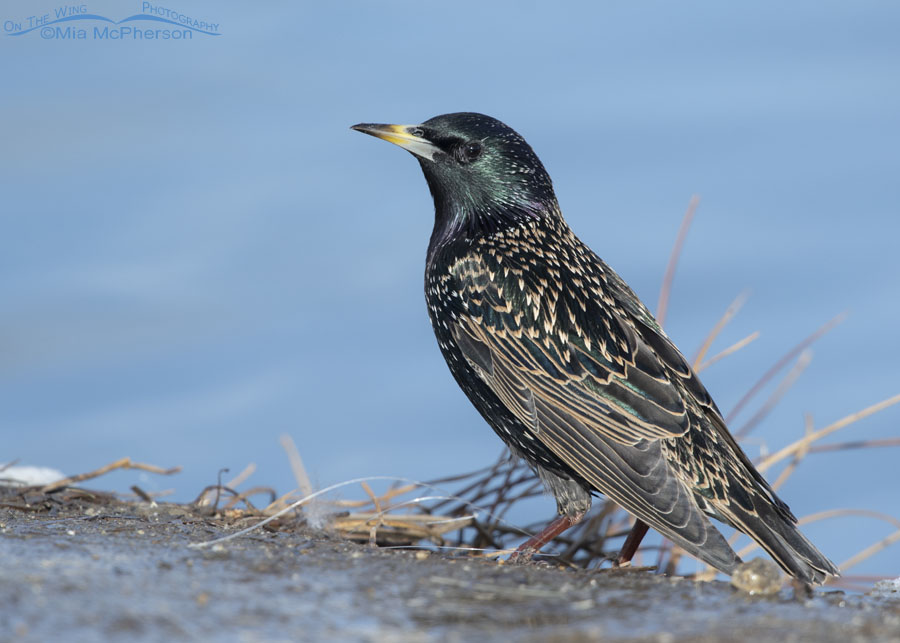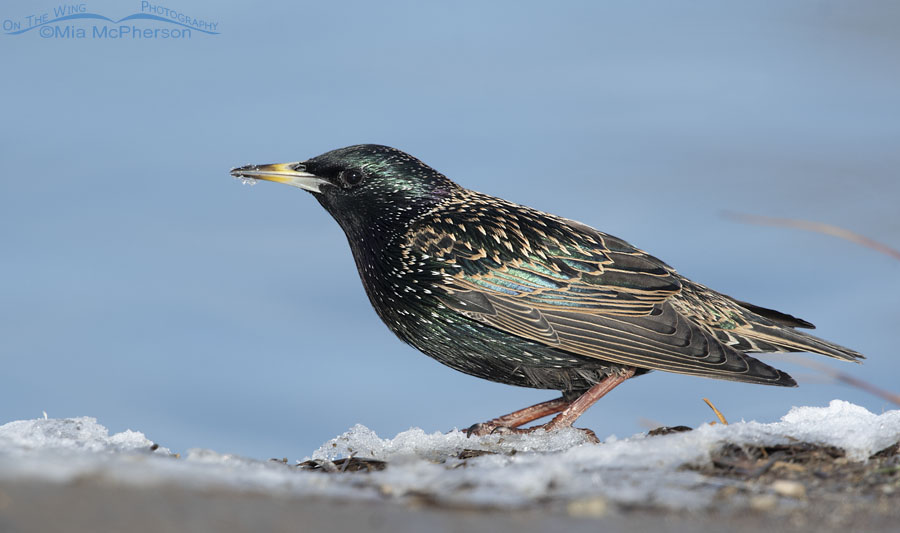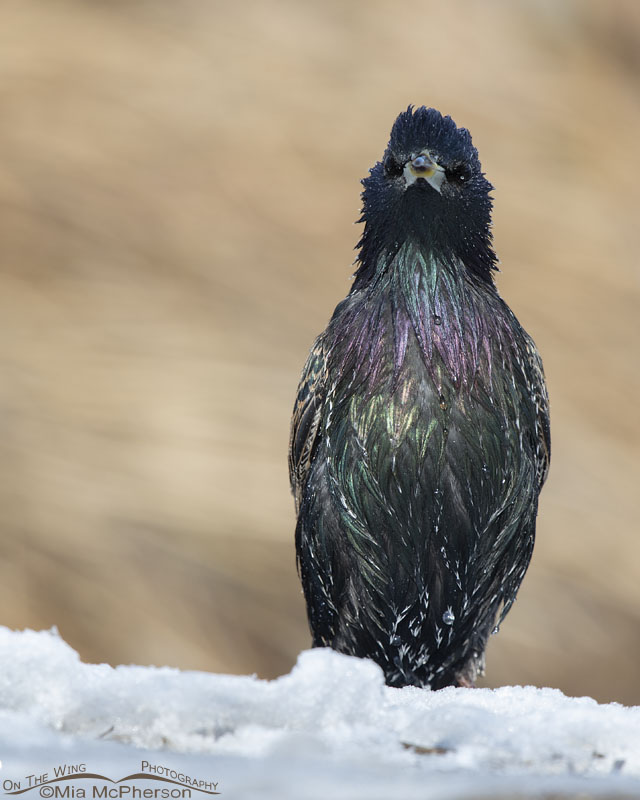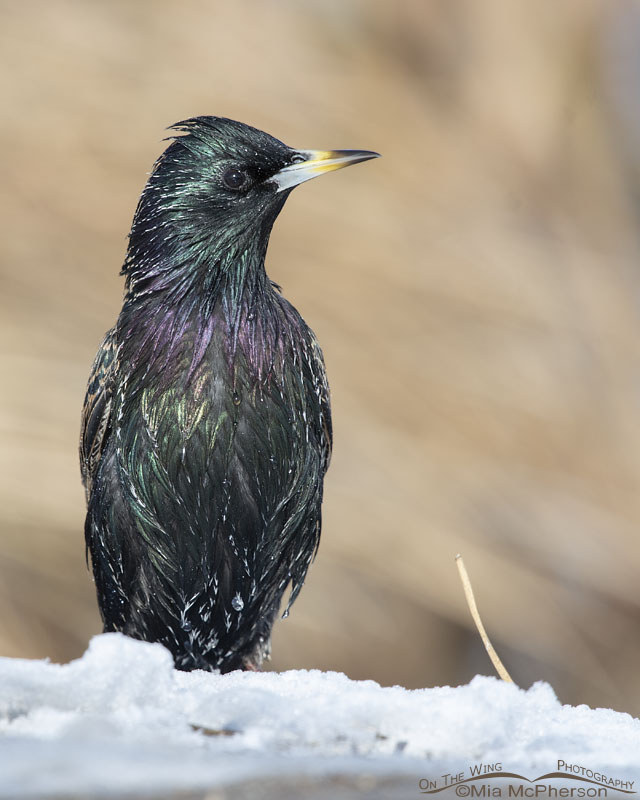 European Starling in winter next to a pond – Nikon D500, f7.1, 1/500, ISO 320, +0.7 EV, Nikkor 500mm VR with 1.4x TC, natural light
European Starling in winter next to a pond – Nikon D500, f7.1, 1/500, ISO 320, +0.7 EV, Nikkor 500mm VR with 1.4x TC, natural light
Three days ago when there was a break in the clouds so I went out in search of birds in the afternoon. Most of the ducks, coots, grebes and gulls were too far away to take high quality images of. I thought I was going to go home without any frame filling bird photos until this European Starling flew in and landed next to the water.
 Pond side European Starling in the snow – Nikon D500, f7.1, 1/640, ISO 320, +0.7 EV, Nikkor 500mm VR with 1.4x TC, natural light
Pond side European Starling in the snow – Nikon D500, f7.1, 1/640, ISO 320, +0.7 EV, Nikkor 500mm VR with 1.4x TC, natural light
The behavior of the starling puzzled me a bit because it ate some snow even though it was just steps away from the pond where it could have had a drink of fresh water. This photo shows some of the snow on the starling’s bill.
I know that it costs birds that eat snow energy to warm the snow up to body temperature so I thought watching and photographing this European Starling and a Ring-billed Gull eating snow this week was interesting.
 Wet and bedraggled European Starling in snow – Nikon D500, f7.1, 1/320, ISO 320, +0.7 EV, Nikkor 500mm VR with 1.4x TC, natural light
Wet and bedraggled European Starling in snow – Nikon D500, f7.1, 1/320, ISO 320, +0.7 EV, Nikkor 500mm VR with 1.4x TC, natural light
The starling disappeared for a few moments when it walked down to the edge of the pond and when it came back into view I could tell that it had taken a bath in the water because it was all wet, looked bedraggled and there were still water droplets clinging to its feathers.
I couldn’t resist laughing when I saw this image on my monitor at home. It looked as if there should be a speech bubble in the frame with a caption that says “Do you mind? A little privacy please?” or something along those lines.
 European Starling after taking a bath in winter – Nikon D500, f7.1, 1/320, ISO 320, +0.7 EV, Nikkor 500mm VR with 1.4x TC, natural light
European Starling after taking a bath in winter – Nikon D500, f7.1, 1/320, ISO 320, +0.7 EV, Nikkor 500mm VR with 1.4x TC, natural light
The wet European Starling quickly shook the water off of its feathers after this photo was taken and flew towards some trees across the water.
I didn’t come home with the gull, duck, geese or grebe photos I thought that I might take but I am happy with these starling images.
Life is good.
Mia
Click here to see more of my European Starling photos plus facts and information about this species.
I am aware there are a lot of people who don’t like starlings and consider them to be horrible pests that cause problems for our native birds but I can’t blame the starlings for being in this country because it was misguided humans who took them from their homeland and released them here about 130 years ago.
When I am photographing European Starlings I don’t think about them being invasive pests, I think of them as wild, feathered, living subjects.


Nice images. Usually I see them lined up on the high wires or in distant but interesting shape-changing flying formations.
Nice timing for that starling to drop in, and excellent photo captures!
Although I’ve heard of European Starlings before, I’ve never seen such vivid close-ups as you’ve captured in these shots. The first thing that struck me was the Starlings distinct pin stripe markings; then I noticed its iridescent hues. Marvelous pics Mia. Thanks.
One of the rehab calls Haley took was about a window strike bird, the woman said it was such a stunningly beautiful bird it must be someones escaped exotic pet. When Haley arrived the injured bird was a starling.
I think they are beautiful and thank you for sharing the wonderful photos.
They are a handsome species.
The post-dunk quote that popped into my head was, “I just washed my feathers and I can’t do a THING with them.” 😉
Love the iridescence. Envy the moisture bringing snow.
I much prefer the non-breeding, speckled plumage to the breeding plumage. Great shots that show up the iridescence.
Beautiful shots Mia. You actually made a bird I usually ignore look beautiful. So glad you shared these photos!
The iridescent coloring of the starling with the blurred background in the last photo is captivating. Excellent photos!
Cool photos, Mia